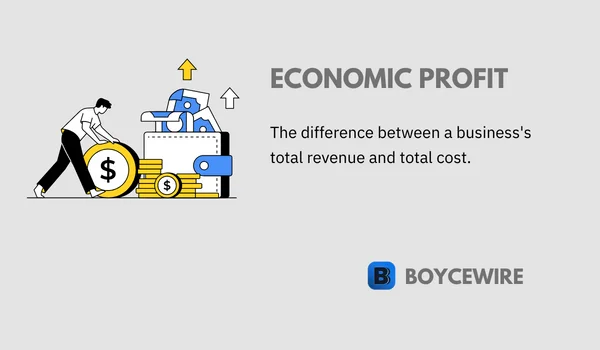Economic Profit: Definition, Pros, Cons & Example

What is Economic Profit
Economic profit is a type of financial measurement that calculates the difference between a firms total sales and its total costs. This includes both explicit and implicit costs.
For explicit costs, these are the monetary expenses such as raw materials, production costs, labor, and rent. In contrast, implicit costs refer to the opportunity cost of taking one decision over another. For instance, investing in a new factory instead of improving product quality.
So economic profit not only takes into consideration a businesses ordinary costs, but also the opportunity cost as well. It goes one step above looking at ordinary accounting profit.
By taking into consideration the opportunity costs, it considers the overall decision making of the firm. If it has a positive economic profit, it suggests that the business is profitable. In other words, it takes decisions which bring more in than the opportunity cost.
Key Points
- Economic profit is a measurement that looks at a firms underlying profitability by considering both explicit and implicit costs.
- It is different from accounting profit as it also factors in the opportunity cost of taking one business decision over another.
- It helps firms identify long-term strategies in order to allocate resources more effectively.
How to Calculate Economic Profit
You can calculate economic profit using the following steps:
- Calculate the firms total revenue over a set period. This will be the money it makes from selling its goods and services.
- Identify the total value of the explicit costs. This is the monetary expenses that the firm has incurred during the year, including items such as maintenance, labor, advertising, rent, and the raw materials.
- Calculate the implicit costs. This is the opportunity cost of taking one course of action over another. For instance, a car manufacturer may choose to build larger cars rather than smaller cars. The implicit cost is the opportunity cost of not making those smaller cars.
- Take away explicit and implicit costs from the firms total revenue.
In turn, from the steps above, we end up with the economic profit. However, we can also see this using the formula below:

Where:
- Total revenue is the total number of sales a firm makes.
- Total explicit costs are equal to the monetary expenses of the firm – such as labor, raw materials etc.
- Total implicit costs are equal to the opportunity cost of taking one action over another.
This provides a better understanding of how profitable a firm is. By also considering the opportunity cost, it looks at how effective decision making is. If firms are making bad decisions, then they are losing money because the alternative would have brought in more.
When the profit is positive, it means the firm is making good decisions which are better than the alternatives. This may mean that it’s an unviable business.
Economic Profit vs. Accounting Profit
Although economic and accounting profit both measure a firms profitability, they are calculated differently, and offer a different barometer by which to measure.
Accounting profit is calculated by taking away explicit costs from the firms total revenue. We can look at this as ‘ordinary’ profit and is what is usually quoted – taking into consideration the businesses costs such as labor, raw materials etc. We usually see this measurement of a firms profitability on its annual reports and financial statements.
By contrast, economic profit does the same, but also subtracts implicit costs. This is the opportunity cost of using its resources in one way as opposed to another. For instance, the use of factory equipment has alternative uses. By taking into consideration the cost of these, we can determine whether the selected course of action was profitable. This therefore provides a more comprehensive outlook on a firms profitability, but is equally more difficult to measure accurately.
Accounting profit is therefore a more straightforward way of measuring a firms profitability, and is most commonly used. However, it doesn’t consider the effectiveness of decision making. By calculating the opportunity cost, we can better identify underlying profitability. Yet there is tremendous difficulty in doing so. There are uncertainties of how profitable the other course of action would be, so cannot truly provide an accurate representation.
Advantages of Economic Profit
Some advantages include:
- Comprehensive: it is a more comprehensive measurement of a firm’s profitability. As it considers both explicit and implicit costs, it is able to better identify a firms underlying profitability.
- Long-term sustainability: it better reflects the companies long-term sustainability as it accounts all the firms costs. As implicit costs are considered, it shows how well the firm is doing with its allocation of resources. If its doing badly on this front, it’s unlikely to be a sustainable business.
- Accurate capital allocation: as implicit costs are included in the calculation, it highlights bad allocation of resources. It therefore allows businesses to assess the opportunity costs of different investments and allocate resources in the most efficient way.
- Better decision-making: by thinking about the detail and opportunity cost of each decision, managers are in a better position to analyse two or more options. The active process of analysing and costing each plan helps created a better informed environment which can lead to more favourable results.
- Investor perspective: from the investors perspective, if the firm is highly profitable, it shows that it is an efficient machine that has a long-term future. This is because it shows the company is earning more than it would be deploying resources elsewhere.
In summary, economic profit is a more comprehensive and accurate measure of a firm’s profitability than accounting profit. It encourages a long-term view, helps to allocate capital more accurately, and facilitates better decision-making by managers and investors.
Disadvantages of Economic Profit
Some disadvantages include:
- Difficult to measure implicit costs: implicit costs can be incredibly difficult to calculate with any degree of accuracy. For instance, if a company chooses to invest in Product A over Product B, it’s difficult to accurately work out how much it would have made from Product B. So although it provides a better overall picture of profitability, it can be less reliable.
- Subjective valuation: whilst implicit costs are a useful tool, they can be subjective. For some, the forecast for different opportunity costs can vary depending on forecasting techniques. As it relies on the expert opinion of the forecaster, it can create bias with a subjective viewpoint.
- Short-term focus: a focus on this type of profit may create a short-term goal on profitability, instead of long-term alternatives that create value. For instance, investing in advertising and marketing can help build brand value and awareness. Yet it may do little to improve profitability in the short-run. For small up-coming business, it may take years of advertising to become a household name. Yet by focusing on economic profit, companies may seek short-term gains instead of long-term investment.
- Unrealistic assumptions: there are a number of assumptions that are needed to made the calculation viable. These assumptions, such as perfect competition do not hold true in the real-world. It also assumes that alternative investments will work in a vacuum. In other words, there wouldn’t be any other effects. For instance, investing in a new product line may incentivise competitors to do the same. However, a different turn of events may occur if a firm invests in advertising.
- Not widely used: this type of profit is a more comprehensive measurement of profitability. However, in reality, it is not used by big businesses. Accounting profit is predominantly used, not necessarily because it is better, but because it is more accurate. Whilst there are some doubts about economic profit, accounting profit is a straight forward mathematical equation.
- Ignoring non-financial factors: in the world of business, there are a wide variety of factors that contribute to underlying profitability and the sustainability of the firm. These can include social and environmental factors. For instance, by polluting the rivers in the short-term, firms may benefit from profits. However, in the long-term it may face undue public disgust and regulatory action against it.
Examples of Economic Profit
Company A sells and producers motor vehicles. In one year, it brings in $1 million. It’s explicit costs from expenses such as raw materials, labor, rent, and advertising, are equal to $650,000. In a simple world, its owners have a single implicit cost of $100,000 – which is the opportunity cost of their time.
Using the formula for economic profit, we can calculate ABC Corporation’s economic profit as follows:
Economic Profit = Total Revenue – Total Explicit Costs – Total Implicit Costs
Economic Profit = $1,000,000 – $650,000 – $100,000 = $250,000
From the formula we can determine that Company A’s economic profit is equal to $250,000. So it is earning more than it would through alternative uses of its resources.
FAQs
Economic profit measures a firms underlying profitability by taking away both its explicit and implicit costs from its revenue. By contrast, accounting profit is simply just the firms revenue minus its explicit costs.
Economic profit is calculated by taking the firms revenue and subtracting away its explicit and implicit costs.
Implicit costs are the opportunity costs of using resources, such as the owner’s time and the use of the firm’s capital. Implicit costs are not reflected in accounting statements and must be estimated.
Economic profit is not widely used in practice because it is more difficult to calculate than accounting profit and relies on several assumptions that may not hold true in the real world. Additionally, many firms and investors still rely on accounting profit as a measure of a firm’s performance.
About Paul
Paul Boyce is an economics editor with over 10 years experience in the industry. Currently working as a consultant within the financial services sector, Paul is the CEO and chief editor of BoyceWire. He has written publications for FEE, the Mises Institute, and many others.

Further Reading
 Porter’s 5 Forces: Definition, Model & Example - Porters 5 forces is a method used to breakdown and understand the competitive nature of an industry or business.
Porter’s 5 Forces: Definition, Model & Example - Porters 5 forces is a method used to breakdown and understand the competitive nature of an industry or business.  Fico Score - A FICO score is a numerical representation of an individual's creditworthiness, calculated based on factors such as payment history, credit…
Fico Score - A FICO score is a numerical representation of an individual's creditworthiness, calculated based on factors such as payment history, credit…  Are Cryptocurrencies Worth the Risk? An Objective Analysis - Table of Contents What is Cryptocurrency What is Cryptocurrency Mining Types of Cryptocurrency How to Buy Cryptocurrency Advantages and Disadvantages…
Are Cryptocurrencies Worth the Risk? An Objective Analysis - Table of Contents What is Cryptocurrency What is Cryptocurrency Mining Types of Cryptocurrency How to Buy Cryptocurrency Advantages and Disadvantages… 
